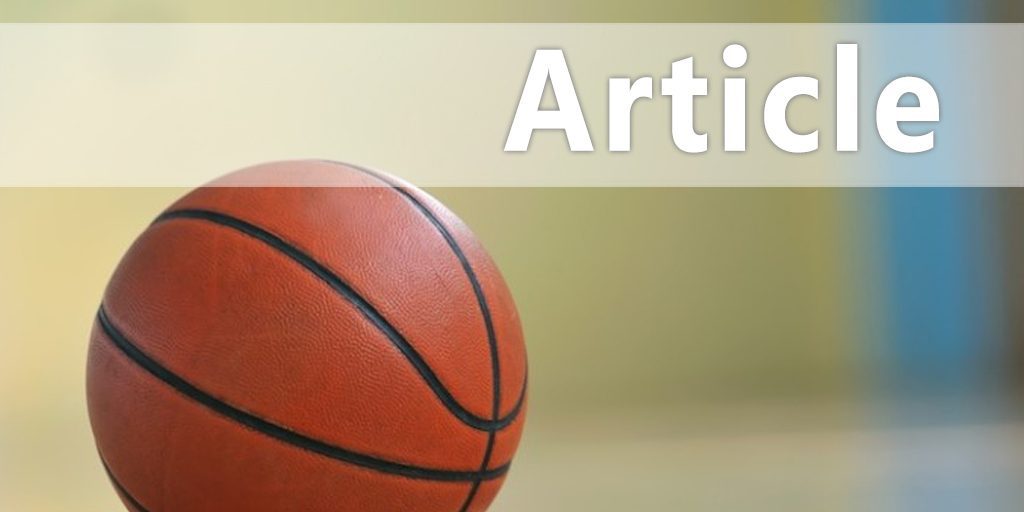| Attacking the Zone
ATTACKING THE ZONE is a comprehensive book that explains our fundamental thoughts in attacking zones. As a Coach try to understand the plans of the enemy and how it thinks once you learn how the Zone thinks and what it reacts to you then can better attack the enemy. The following pages will help explain the fundamental thoughts in attacking zones. THE UNIVERSITY OF NORTH CAROLINA- WBB
There are certain fundamental thoughts to keep in mind as we attack the Zone as it relates to how the Zone thinks and operates. First, I have always thought that all zones look alike when the ball goes to the baseline. With that in mind, I think we can attack all zones similarly. The late Press Maravich, who I had great respect for as a person and a basketball coach, said, "You have to make a decision in attacking zone defenses: Do you want to move the ball, do you want to move the man, or do you want to move both?" This brings me to my second fundamental thought. As we attack zone defenses here at The University of North Carolina, we have decided to move both; the ball and the man. Our third fundamental thought concerns distortion of the zone's slides. By moving the ball and the man we can force the zone to cover different areas (distortion) than they normally cover in practice. By forcing the zone to cover abnormal areas, by distorting their slides, you also cause distortion in the thinking process their coach has set up. This third point is the key to our zone offense. Simply passing the ball will not beat a good zone defense. Zones were set up long ago to negate and slide with the different passes. Therefore, the strength of a zone comes through covering the different passes. So, we distort the zone slides to alleviate this natural strength in the zone defense. An example of how we distort a zone through ball and man movement is to penetrate the natural gaps in a zone with effective use of the dribble. When used intelligently, the dribble can create the necessary distortion. By simply passing the ball around the perimeter, it is difficult to get the zone into unfamiliar double coverage areas. It is of paramount importance in our zone offense to use the dribble for penetrating gaps and making an offense that is hard to play against. In Diagram 1 we see the dribble penetration of the zone gaps: 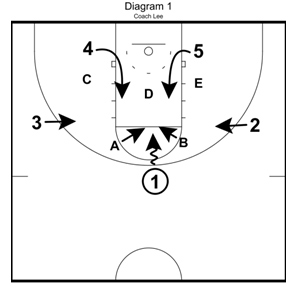 Here, the ball is driven into the gap between the two defensive players. This causes two defensive players to come to the basketball. This opens a 2 on 1 advantage for our offense elsewhere. And we would step in and move to take advantage of this situation. A second way to distort the zone's coverage would be the use of stacks, primarily a man movement tactic. We have used a high-low stack, a double low stack, or even a triple stack. As you can see in Diagram 2, there are no logical people to guard in one area. (B, E) One defender may have nobody in his area, while another defender may have two or even three people to guard in his coverage area. (C) This type of distortion, just as gap penetration, causes confusion in the thinking process of the zone's coverage. (Stacks can be used as an entry into the basic zone attacks we will cover later). 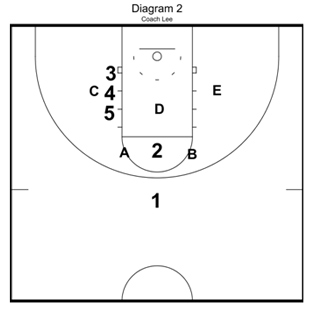 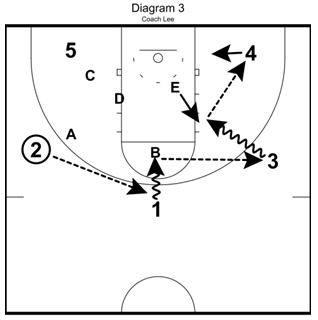 A related thought with regard to the weakness of a zone defense during its recovery phase, is my opinion that the zone will not recover the same way twice. This difference in recovery may be caused by fatigue (the defender may come hard one time and slow the next because of fatigue) and/or the angle of recovery (because of different offensive and defensive positioning). This weakness coupled with the inherent weakness of the recovery phase is why we believe this is the primary time to attack the zone. A final fundamental thought in this introduction to our zone offense philosophy and attack relates to patience. It only requires a little patience to get an uncontested jump shot. It is not necessary to shoot contested perimeter jump shots. This patience factor is directly related to the ball reversal concept and the fact a zone defense is weakest while recovering from ballside attack. We encourage displaying this patience by reversing the ball to at least 3 people, thus creating the recovery phase weakness discussed earlier. 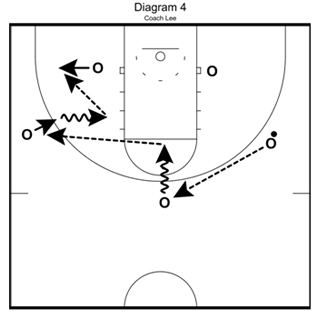 Just as our entire system is built on fundamentals and simplicity, so is our zone attack. Though many great programs are successful with change and surprise, our philosophy focuses on executing the basics of the game in the easiest manner. Within this philosophy, we think the zone naturally reacts to the basketball and what it does. Therefore, it is our desire to use this natural tendency to our advantage; using several simple fundamentals to attack the zone defense. In this chapter we will cover the use of the shot fake and pass fake. The following chapter will demonstrate the effective use of the dribble along with the principle of ball reversal. Because of the sensitivity of the zone's reaction to the ball, the use of shot and pass fakes becomes an extremely important fundamental. (Note: These 2 fundamentals are also important in our passing game versus man to man.) These components of the zone attack will increase in their effectiveness when used against the recovery phase of the zone defense. In this situation it is critical to emphasize that we keep good shooters spread opposite the basketball for the attack during ball reversal and the recovery of the zone. Do not bring the ball down and go immediately to your shooters. The pass fake is vital to move and hold the zone. (Remember zones react to the ball.) These fakes can open opportunities for better passing angles, driving opportunities, plus shooting opportunities. Your offense must understand how to take advantage of the pass fake in reading the defensive movement. (See Diagram # 5) 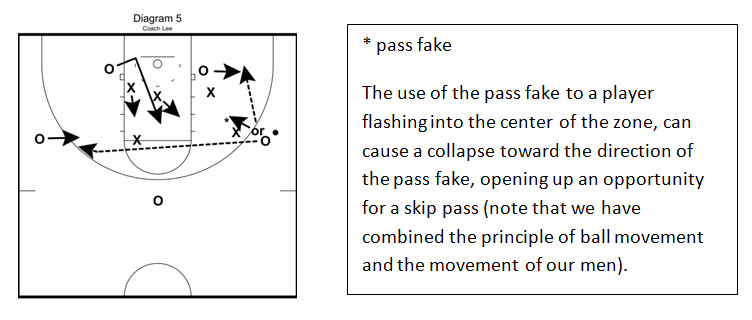 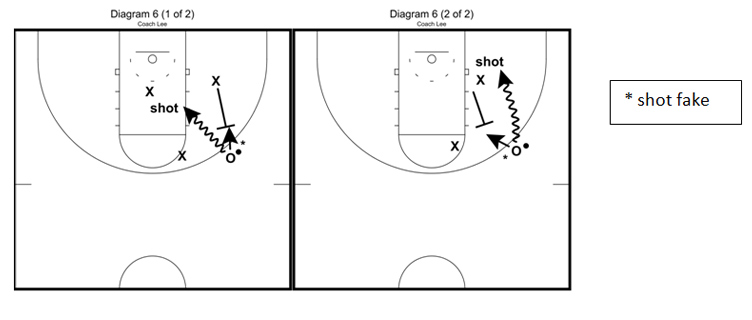 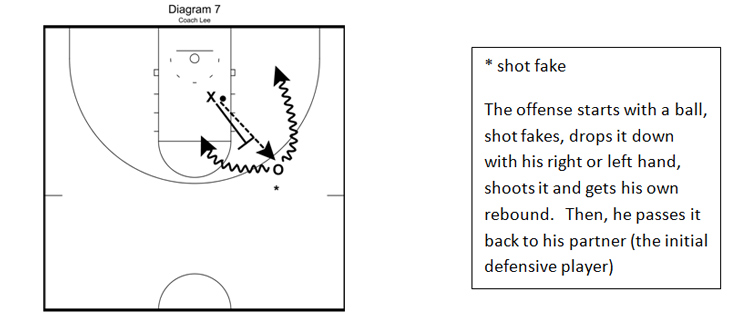 At this stage in my coaching career, all of our shooting drills possess at least one of these three characteristics: These characteristics expand on the above point of incorporating these simple fundamentals into combination drills. Because of this thinking, we do not encourage free shooting. For every drill in which you shoot, you need to use shot fakes. We want all of our players to be very good at deception through the execution of shot fakes and pass fakes and movement fakes. CHAPTER 3 EFFECTIVE USE OF THE DRIBBLE Effective use of the dribble reflects our premise that zones react to the ball, not to the players. The diagram below shows a 2-3 (Diagram # 8) zone and the circles represent each defensive player coverage areas. The overlapse in the circles show the area, or gaps where we want to force the zone into double coverage. When we can penetrate the zone with a dribble at one of these gap areas we have forced the defense to make a critical decision on who will cover the penetration. This usually will force the 2 defensive players involved to momentarily commit themselves to the ball. At this point, we must read the defense and take the ball to the action (or scoring opportunity) creating: a 2 on 1 offensive situation elsewhere. 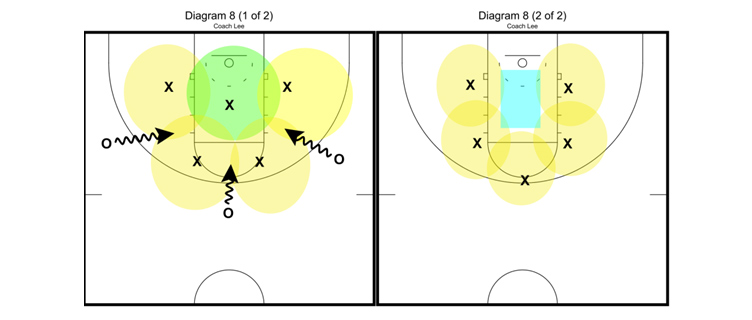 We begin our zone offense the first day of practice. As we begin preparing for the season, we realize that we are probably going to play against more zone defenses than man defenses. With regard to penetration of the gaps, the first dribble we can use is "to drive the gap." The ball is driven into the gap with one dribble, then quickly pulled back, stepping back toward the perimeter. By doing so, you force 2 players to guard you. This causes the necessary double coverage which creates the possible 2 on 1 opportunity. You have also placed yourself in a position to move the ball on to action of the open people for scoring opportunities. These are our objectives in penetrating the gaps with the dribble. The 1st drill we introduce to teach gap penetration is to put up a 1-2-2 zone and place our offense in a box alignment. 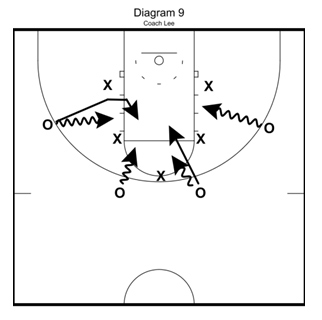 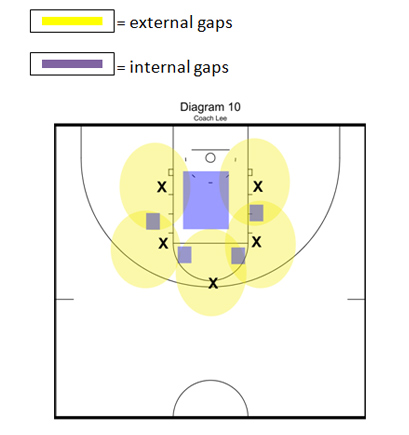 Continuing with our Gap Penetration drill we want to especially emphasize the shot fake and pass fake. We are not trying to "shoot" the ball in this drill. (A good idea is to later use restrictions on the offense as to when and who will shoot. This will create discipline, communication, and concentration while it keeps the defense more realistic and honest than if you told the offense they could not shoot.) The main drill objective is to work on the execution of our zone offense fundamentals: gap penetration (step back dribble), flashing from behind the zone (into internal gaps), pass fakes, and shot fakes. An added benefit of the drill is the 4 on 5 aspect for the offense. Even with the disadvantage, they should be able to create scoring opportunities which should increase their confidence when they face the zone 5 on 5. The second drill we employ has a 4 on 4 situation. It involves a 2-3 zone with no middle man, 3 perimeter players, and 1 post offensive players. The 3 perimeter players attack external gaps or flash from behind into the internal gaps. The post will flash from behind as well, looking for daylight within the internal gaps. The perimeter can use the step-back dribble and drop the ball off to a teammate when they penetrate. At this point I will then introduce our next dribble: 'take it off the top of the key.' Taking the ball 'off the top,' as we call it, is a method of dribbling the ball off the top of the key toward the corner. The objective is to move the top of the zone over and open a good opportunity to attack the zone with ball reversal. Notice that all five men on defense have moved because the zone is reacting to the ball being dribbled. See Diagram # 11 below: 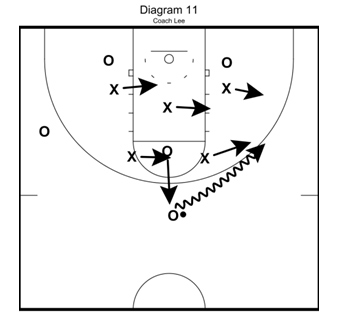 With this dribble, one man has done the work of two men passing, as far as ball position is concerned, and he has done the job more effectively because of the use of his dribble. A key teaching point in taking it off the top is that the dribbler must take it as far as the coverage will go – to the defensive man's coverage area limits. Then, he must take one more dribble and penetrate, forcing the defense to take one more critical step. This sets up our ball reversal a little better and will cause the next defensive player over to make a decision about his coverage because our man with the ball is in a gap, at the edge of his coverage area. So, take the defensive player off the top to the limits of the player's coverage area, then take one more dribble in, forcing the defense to take one more step, and now reverse the ball quickly. See diagram # 12: 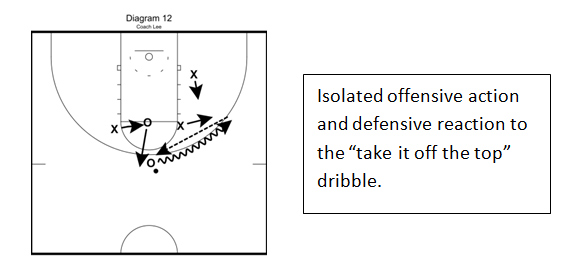 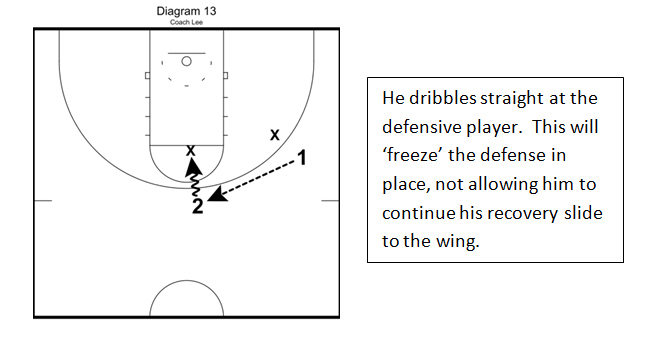 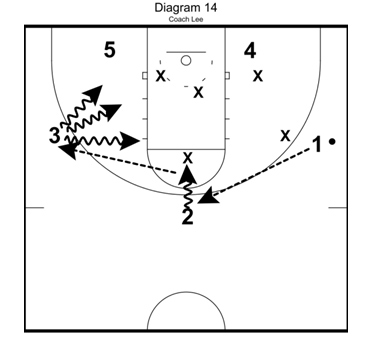 A final scoring opportunity is possible when we penetrate this large gap. If the back man reacts to the penetration, a post player (or perimeter player in the post area) can be available for the pass, by stepping out to the short corner. See Diagram 15 below. 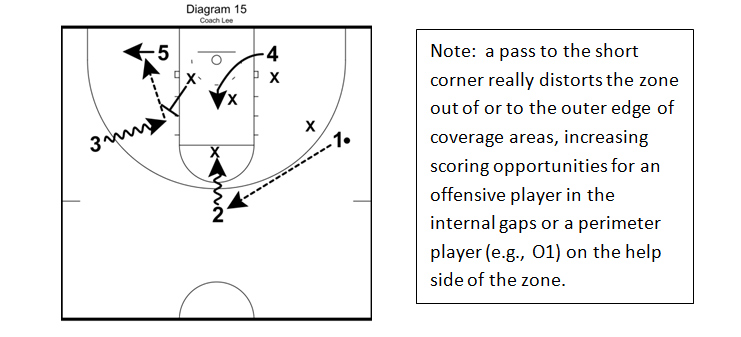 When we use the step-back dribble at the top after gap penetration, we create a situation similar to what we want to occur when we have dribble penetration versus a man to man. That is, when the step-back dribble is used, we want a post man to flash to the ball. The step-back dribble is the key for the post man to flash. This brings us to our next chapter and how we attack the middle man of the zone. This will be the next step in our teaching progression and the use of effective dribbling. Note: 3 other dribbles which are equally important are "take it to the top," "take if off the baseline", and the "gap penetration dribble." These will be covered in future chapters on "Attacking the Middle Man" and "Post Principles," rather than in this chapter on the dribble. I believe it will be more appropriate to introduce and incorporate these other 3 dribbles into more specific situations.
|
|
|
About the Author... |
|
|
| Billy Lee is in his first year as the director of video services and scouting for women's basketball. A well-respected coach with a long history in the state of North Carolina, Lee has over three decades of coaching experience.
A 1969 graduate of Mount Olive College, Lee was an assistant coach at East Carolina for two seasons before taking the head job at Pembroke State (now UNC Pembroke) in 1978. During his time in Lumberton, Lee won three conference titles, advanced to the NAIA National Tournament and posted back-to-back 20-win seasons. In 1985, Lee took over as the head men's coach at Campbell, where he led the Camels for 18 seasons. A five-time conference coach of the year, Lee guided Campbell to the 1992 Big South Conference title and a bid to the NCAA Tournament, where his team faced eventual national champion Duke. In addition to winning over 400 games in his career, Lee was the director the Campbell University Basketball School, considered to be the largest and oldest of its kind in the United States. After leaving Campbell in 2003, Lee spent three seasons at St. Andrews before retiring from the coaching ranks to work as a basketball consultant and television analyst. In addition to his work on the sidelines, Lee has authored two books on basketball strategy. Lee has also been part of a number of organizations including the USA Basketball committee, the Board of Directors for the North Carolina Amateur Sports Association, the National Association of Basketball Coaches, the Board of Advisors for the NC High School Athletic Association and the National Speakers Association. In 2009, Lee was inducted into the Mount Olive College Athletics Hall of Fame. Lee is married to Wendy Lee, the head women's basketball coach at Mount Olive. His son Brooks is the director of operations for the men's basketball team at UNC Wilmington. |


